Analyzing Workforce Motivation at Tesco Using Established Theories
VerifiedAdded on 2023/06/08
|8
|1456
|457
Report
AI Summary
This report analyzes workforce motivation at Tesco using established theories, focusing on Maslow's Hierarchy of Needs and Herzberg's Two-Factor Theory. It examines how Tesco applies these theories to enhance employee engagement, job satisfaction, and overall performance. The report discusses physiological, safety, love and belonging, esteem, and self-actualization needs within the context of Tesco's operational environment, as well as hygiene and motivator factors influencing employee behavior. Ultimately, it highlights the importance of understanding and addressing employee needs and preferences to achieve organizational goals and reduce employee turnover, with Desklib providing additional resources and solved assignments for further study.
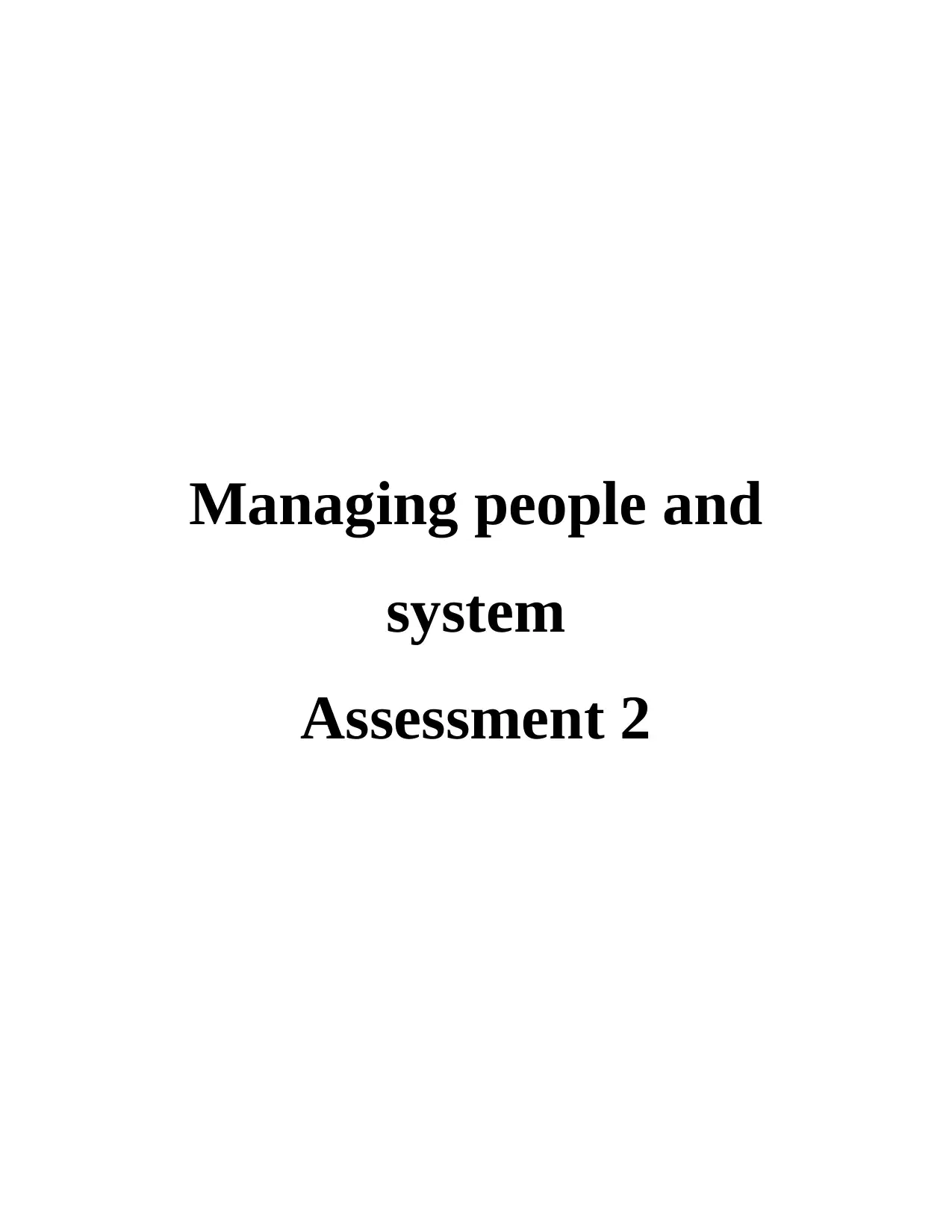
Managing people and
system
Assessment 2
system
Assessment 2
Paraphrase This Document
Need a fresh take? Get an instant paraphrase of this document with our AI Paraphraser
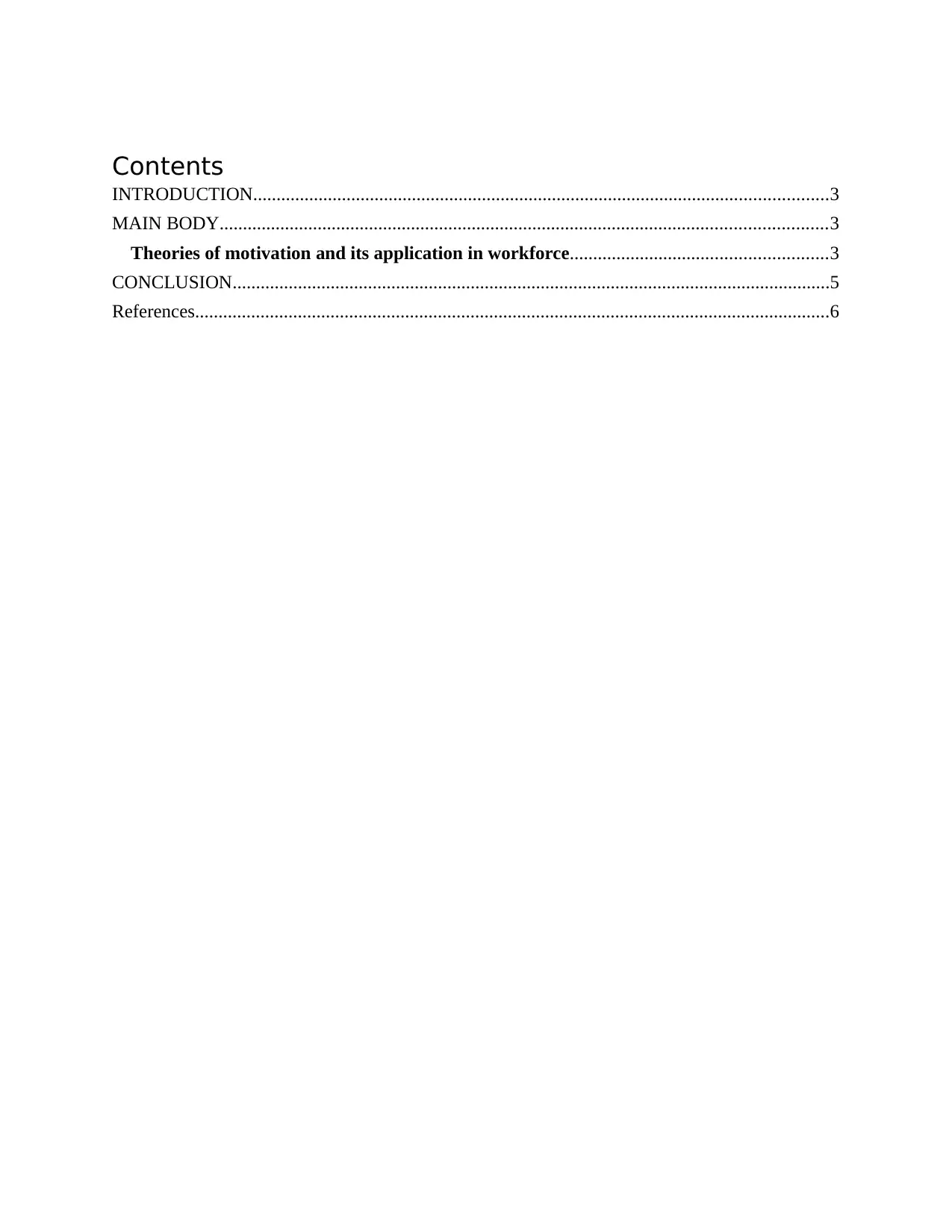
Contents
INTRODUCTION...........................................................................................................................3
MAIN BODY..................................................................................................................................3
Theories of motivation and its application in workforce.......................................................3
CONCLUSION................................................................................................................................5
References........................................................................................................................................6
INTRODUCTION...........................................................................................................................3
MAIN BODY..................................................................................................................................3
Theories of motivation and its application in workforce.......................................................3
CONCLUSION................................................................................................................................5
References........................................................................................................................................6
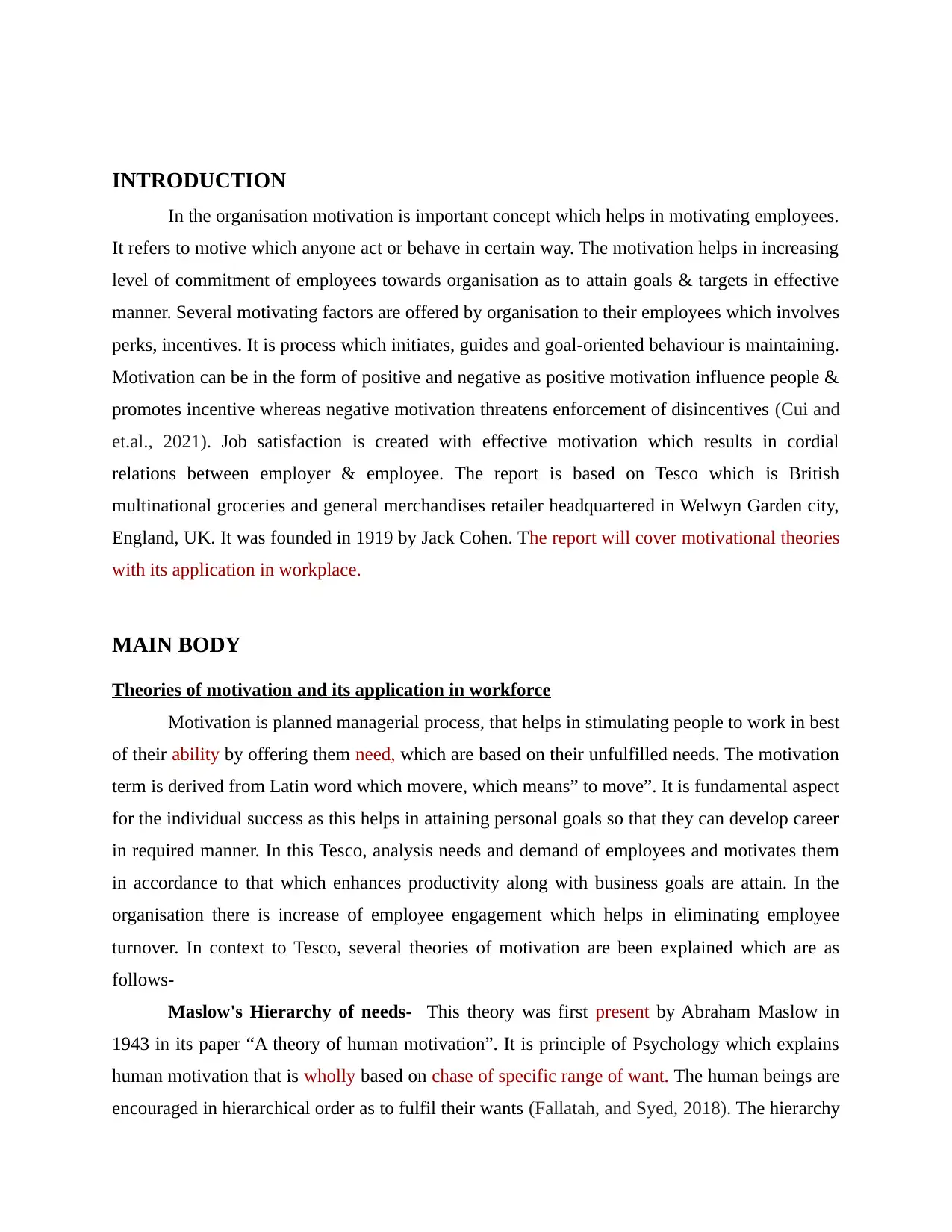
INTRODUCTION
In the organisation motivation is important concept which helps in motivating employees.
It refers to motive which anyone act or behave in certain way. The motivation helps in increasing
level of commitment of employees towards organisation as to attain goals & targets in effective
manner. Several motivating factors are offered by organisation to their employees which involves
perks, incentives. It is process which initiates, guides and goal-oriented behaviour is maintaining.
Motivation can be in the form of positive and negative as positive motivation influence people &
promotes incentive whereas negative motivation threatens enforcement of disincentives (Cui and
et.al., 2021). Job satisfaction is created with effective motivation which results in cordial
relations between employer & employee. The report is based on Tesco which is British
multinational groceries and general merchandises retailer headquartered in Welwyn Garden city,
England, UK. It was founded in 1919 by Jack Cohen. The report will cover motivational theories
with its application in workplace.
MAIN BODY
Theories of motivation and its application in workforce
Motivation is planned managerial process, that helps in stimulating people to work in best
of their ability by offering them need, which are based on their unfulfilled needs. The motivation
term is derived from Latin word which movere, which means” to move”. It is fundamental aspect
for the individual success as this helps in attaining personal goals so that they can develop career
in required manner. In this Tesco, analysis needs and demand of employees and motivates them
in accordance to that which enhances productivity along with business goals are attain. In the
organisation there is increase of employee engagement which helps in eliminating employee
turnover. In context to Tesco, several theories of motivation are been explained which are as
follows-
Maslow's Hierarchy of needs- This theory was first present by Abraham Maslow in
1943 in its paper “A theory of human motivation”. It is principle of Psychology which explains
human motivation that is wholly based on chase of specific range of want. The human beings are
encouraged in hierarchical order as to fulfil their wants (Fallatah, and Syed, 2018). The hierarchy
In the organisation motivation is important concept which helps in motivating employees.
It refers to motive which anyone act or behave in certain way. The motivation helps in increasing
level of commitment of employees towards organisation as to attain goals & targets in effective
manner. Several motivating factors are offered by organisation to their employees which involves
perks, incentives. It is process which initiates, guides and goal-oriented behaviour is maintaining.
Motivation can be in the form of positive and negative as positive motivation influence people &
promotes incentive whereas negative motivation threatens enforcement of disincentives (Cui and
et.al., 2021). Job satisfaction is created with effective motivation which results in cordial
relations between employer & employee. The report is based on Tesco which is British
multinational groceries and general merchandises retailer headquartered in Welwyn Garden city,
England, UK. It was founded in 1919 by Jack Cohen. The report will cover motivational theories
with its application in workplace.
MAIN BODY
Theories of motivation and its application in workforce
Motivation is planned managerial process, that helps in stimulating people to work in best
of their ability by offering them need, which are based on their unfulfilled needs. The motivation
term is derived from Latin word which movere, which means” to move”. It is fundamental aspect
for the individual success as this helps in attaining personal goals so that they can develop career
in required manner. In this Tesco, analysis needs and demand of employees and motivates them
in accordance to that which enhances productivity along with business goals are attain. In the
organisation there is increase of employee engagement which helps in eliminating employee
turnover. In context to Tesco, several theories of motivation are been explained which are as
follows-
Maslow's Hierarchy of needs- This theory was first present by Abraham Maslow in
1943 in its paper “A theory of human motivation”. It is principle of Psychology which explains
human motivation that is wholly based on chase of specific range of want. The human beings are
encouraged in hierarchical order as to fulfil their wants (Fallatah, and Syed, 2018). The hierarchy
⊘ This is a preview!⊘
Do you want full access?
Subscribe today to unlock all pages.

Trusted by 1+ million students worldwide
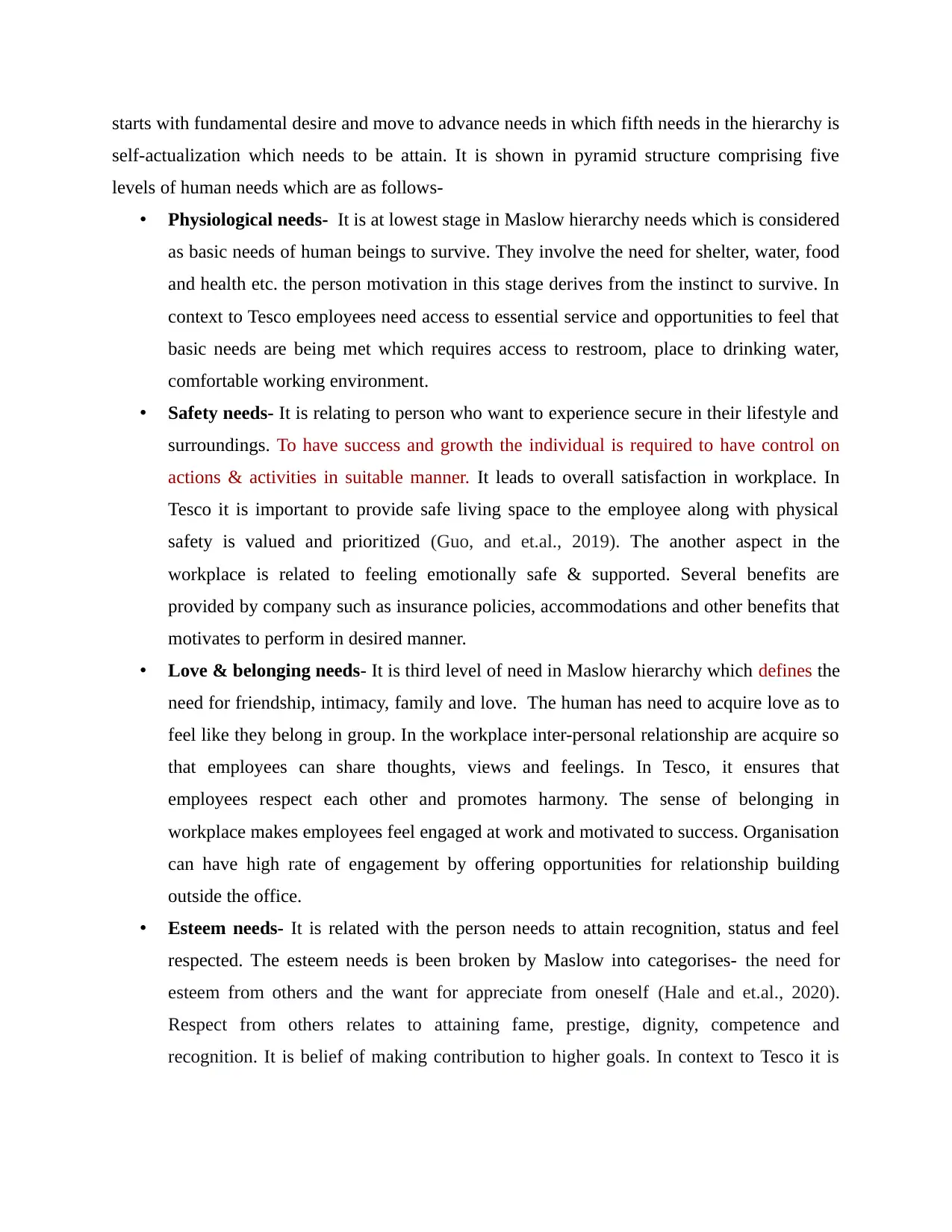
starts with fundamental desire and move to advance needs in which fifth needs in the hierarchy is
self-actualization which needs to be attain. It is shown in pyramid structure comprising five
levels of human needs which are as follows-
• Physiological needs- It is at lowest stage in Maslow hierarchy needs which is considered
as basic needs of human beings to survive. They involve the need for shelter, water, food
and health etc. the person motivation in this stage derives from the instinct to survive. In
context to Tesco employees need access to essential service and opportunities to feel that
basic needs are being met which requires access to restroom, place to drinking water,
comfortable working environment.
• Safety needs- It is relating to person who want to experience secure in their lifestyle and
surroundings. To have success and growth the individual is required to have control on
actions & activities in suitable manner. It leads to overall satisfaction in workplace. In
Tesco it is important to provide safe living space to the employee along with physical
safety is valued and prioritized (Guo, and et.al., 2019). The another aspect in the
workplace is related to feeling emotionally safe & supported. Several benefits are
provided by company such as insurance policies, accommodations and other benefits that
motivates to perform in desired manner.
• Love & belonging needs- It is third level of need in Maslow hierarchy which defines the
need for friendship, intimacy, family and love. The human has need to acquire love as to
feel like they belong in group. In the workplace inter-personal relationship are acquire so
that employees can share thoughts, views and feelings. In Tesco, it ensures that
employees respect each other and promotes harmony. The sense of belonging in
workplace makes employees feel engaged at work and motivated to success. Organisation
can have high rate of engagement by offering opportunities for relationship building
outside the office.
• Esteem needs- It is related with the person needs to attain recognition, status and feel
respected. The esteem needs is been broken by Maslow into categorises- the need for
esteem from others and the want for appreciate from oneself (Hale and et.al., 2020).
Respect from others relates to attaining fame, prestige, dignity, competence and
recognition. It is belief of making contribution to higher goals. In context to Tesco it is
self-actualization which needs to be attain. It is shown in pyramid structure comprising five
levels of human needs which are as follows-
• Physiological needs- It is at lowest stage in Maslow hierarchy needs which is considered
as basic needs of human beings to survive. They involve the need for shelter, water, food
and health etc. the person motivation in this stage derives from the instinct to survive. In
context to Tesco employees need access to essential service and opportunities to feel that
basic needs are being met which requires access to restroom, place to drinking water,
comfortable working environment.
• Safety needs- It is relating to person who want to experience secure in their lifestyle and
surroundings. To have success and growth the individual is required to have control on
actions & activities in suitable manner. It leads to overall satisfaction in workplace. In
Tesco it is important to provide safe living space to the employee along with physical
safety is valued and prioritized (Guo, and et.al., 2019). The another aspect in the
workplace is related to feeling emotionally safe & supported. Several benefits are
provided by company such as insurance policies, accommodations and other benefits that
motivates to perform in desired manner.
• Love & belonging needs- It is third level of need in Maslow hierarchy which defines the
need for friendship, intimacy, family and love. The human has need to acquire love as to
feel like they belong in group. In the workplace inter-personal relationship are acquire so
that employees can share thoughts, views and feelings. In Tesco, it ensures that
employees respect each other and promotes harmony. The sense of belonging in
workplace makes employees feel engaged at work and motivated to success. Organisation
can have high rate of engagement by offering opportunities for relationship building
outside the office.
• Esteem needs- It is related with the person needs to attain recognition, status and feel
respected. The esteem needs is been broken by Maslow into categorises- the need for
esteem from others and the want for appreciate from oneself (Hale and et.al., 2020).
Respect from others relates to attaining fame, prestige, dignity, competence and
recognition. It is belief of making contribution to higher goals. In context to Tesco it is
Paraphrase This Document
Need a fresh take? Get an instant paraphrase of this document with our AI Paraphraser
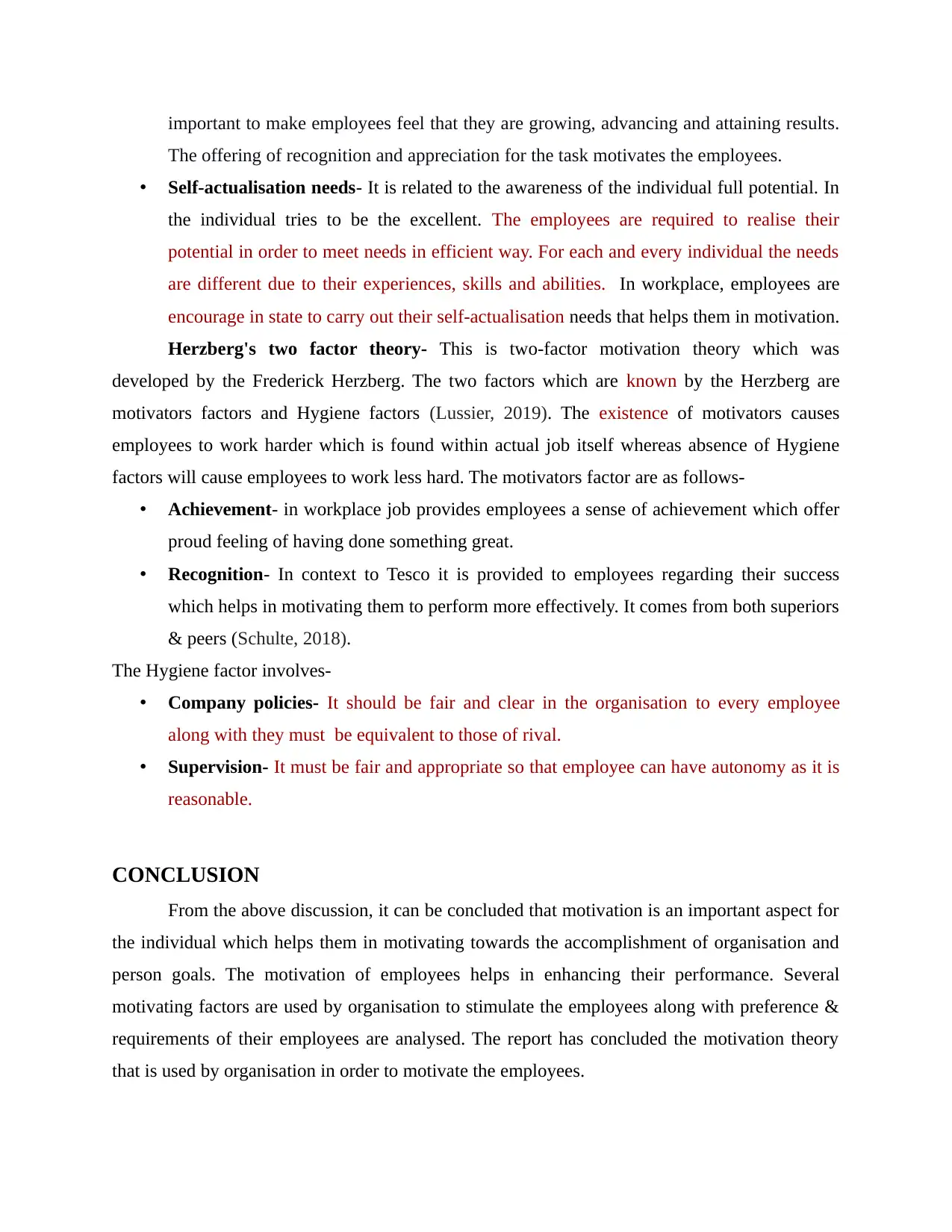
important to make employees feel that they are growing, advancing and attaining results.
The offering of recognition and appreciation for the task motivates the employees.
• Self-actualisation needs- It is related to the awareness of the individual full potential. In
the individual tries to be the excellent. The employees are required to realise their
potential in order to meet needs in efficient way. For each and every individual the needs
are different due to their experiences, skills and abilities. In workplace, employees are
encourage in state to carry out their self-actualisation needs that helps them in motivation.
Herzberg's two factor theory- This is two-factor motivation theory which was
developed by the Frederick Herzberg. The two factors which are known by the Herzberg are
motivators factors and Hygiene factors (Lussier, 2019). The existence of motivators causes
employees to work harder which is found within actual job itself whereas absence of Hygiene
factors will cause employees to work less hard. The motivators factor are as follows-
• Achievement- in workplace job provides employees a sense of achievement which offer
proud feeling of having done something great.
• Recognition- In context to Tesco it is provided to employees regarding their success
which helps in motivating them to perform more effectively. It comes from both superiors
& peers (Schulte, 2018).
The Hygiene factor involves-
• Company policies- It should be fair and clear in the organisation to every employee
along with they must be equivalent to those of rival.
• Supervision- It must be fair and appropriate so that employee can have autonomy as it is
reasonable.
CONCLUSION
From the above discussion, it can be concluded that motivation is an important aspect for
the individual which helps them in motivating towards the accomplishment of organisation and
person goals. The motivation of employees helps in enhancing their performance. Several
motivating factors are used by organisation to stimulate the employees along with preference &
requirements of their employees are analysed. The report has concluded the motivation theory
that is used by organisation in order to motivate the employees.
The offering of recognition and appreciation for the task motivates the employees.
• Self-actualisation needs- It is related to the awareness of the individual full potential. In
the individual tries to be the excellent. The employees are required to realise their
potential in order to meet needs in efficient way. For each and every individual the needs
are different due to their experiences, skills and abilities. In workplace, employees are
encourage in state to carry out their self-actualisation needs that helps them in motivation.
Herzberg's two factor theory- This is two-factor motivation theory which was
developed by the Frederick Herzberg. The two factors which are known by the Herzberg are
motivators factors and Hygiene factors (Lussier, 2019). The existence of motivators causes
employees to work harder which is found within actual job itself whereas absence of Hygiene
factors will cause employees to work less hard. The motivators factor are as follows-
• Achievement- in workplace job provides employees a sense of achievement which offer
proud feeling of having done something great.
• Recognition- In context to Tesco it is provided to employees regarding their success
which helps in motivating them to perform more effectively. It comes from both superiors
& peers (Schulte, 2018).
The Hygiene factor involves-
• Company policies- It should be fair and clear in the organisation to every employee
along with they must be equivalent to those of rival.
• Supervision- It must be fair and appropriate so that employee can have autonomy as it is
reasonable.
CONCLUSION
From the above discussion, it can be concluded that motivation is an important aspect for
the individual which helps them in motivating towards the accomplishment of organisation and
person goals. The motivation of employees helps in enhancing their performance. Several
motivating factors are used by organisation to stimulate the employees along with preference &
requirements of their employees are analysed. The report has concluded the motivation theory
that is used by organisation in order to motivate the employees.

⊘ This is a preview!⊘
Do you want full access?
Subscribe today to unlock all pages.

Trusted by 1+ million students worldwide
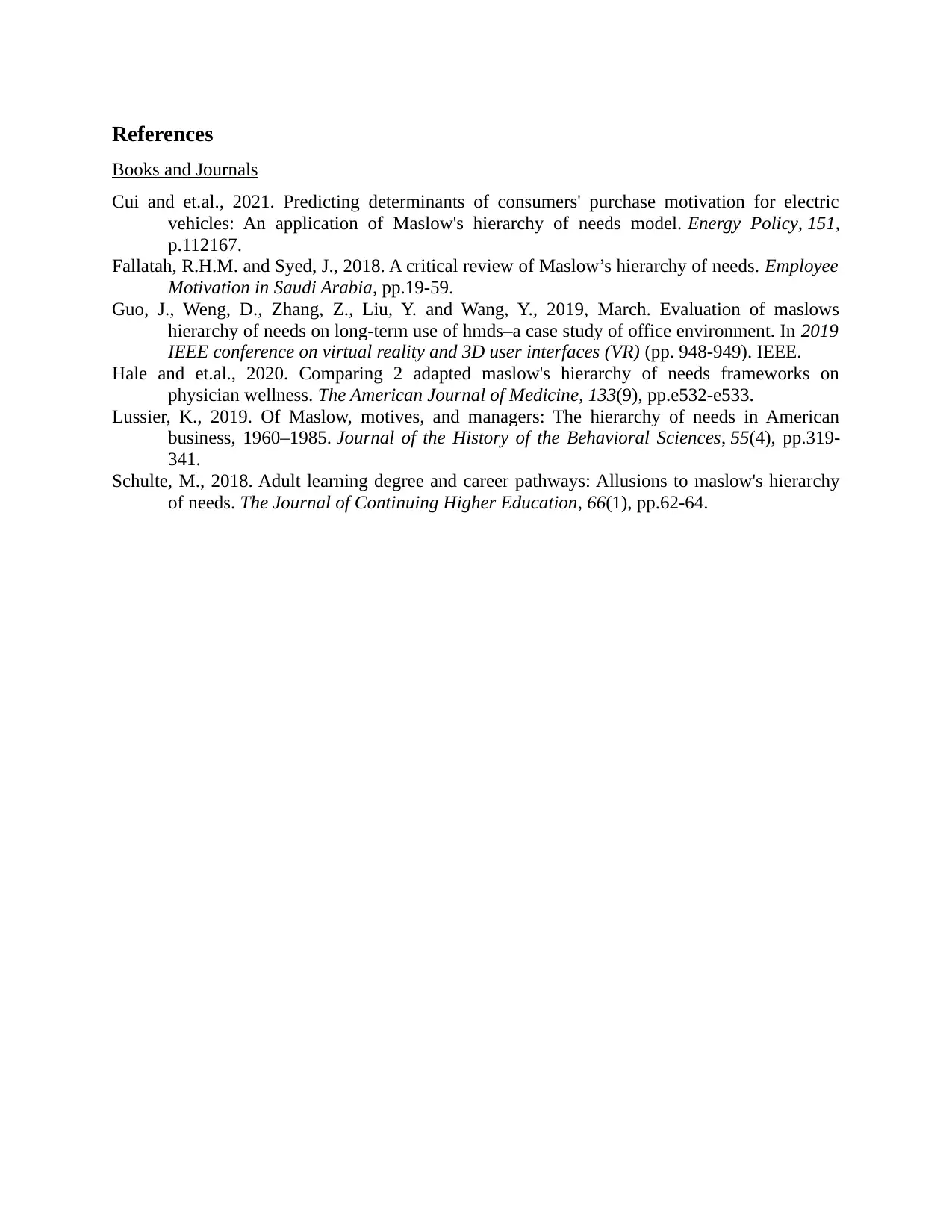
References
Books and Journals
Cui and et.al., 2021. Predicting determinants of consumers' purchase motivation for electric
vehicles: An application of Maslow's hierarchy of needs model. Energy Policy, 151,
p.112167.
Fallatah, R.H.M. and Syed, J., 2018. A critical review of Maslow’s hierarchy of needs. Employee
Motivation in Saudi Arabia, pp.19-59.
Guo, J., Weng, D., Zhang, Z., Liu, Y. and Wang, Y., 2019, March. Evaluation of maslows
hierarchy of needs on long-term use of hmds–a case study of office environment. In 2019
IEEE conference on virtual reality and 3D user interfaces (VR) (pp. 948-949). IEEE.
Hale and et.al., 2020. Comparing 2 adapted maslow's hierarchy of needs frameworks on
physician wellness. The American Journal of Medicine, 133(9), pp.e532-e533.
Lussier, K., 2019. Of Maslow, motives, and managers: The hierarchy of needs in American
business, 1960–1985. Journal of the History of the Behavioral Sciences, 55(4), pp.319-
341.
Schulte, M., 2018. Adult learning degree and career pathways: Allusions to maslow's hierarchy
of needs. The Journal of Continuing Higher Education, 66(1), pp.62-64.
Books and Journals
Cui and et.al., 2021. Predicting determinants of consumers' purchase motivation for electric
vehicles: An application of Maslow's hierarchy of needs model. Energy Policy, 151,
p.112167.
Fallatah, R.H.M. and Syed, J., 2018. A critical review of Maslow’s hierarchy of needs. Employee
Motivation in Saudi Arabia, pp.19-59.
Guo, J., Weng, D., Zhang, Z., Liu, Y. and Wang, Y., 2019, March. Evaluation of maslows
hierarchy of needs on long-term use of hmds–a case study of office environment. In 2019
IEEE conference on virtual reality and 3D user interfaces (VR) (pp. 948-949). IEEE.
Hale and et.al., 2020. Comparing 2 adapted maslow's hierarchy of needs frameworks on
physician wellness. The American Journal of Medicine, 133(9), pp.e532-e533.
Lussier, K., 2019. Of Maslow, motives, and managers: The hierarchy of needs in American
business, 1960–1985. Journal of the History of the Behavioral Sciences, 55(4), pp.319-
341.
Schulte, M., 2018. Adult learning degree and career pathways: Allusions to maslow's hierarchy
of needs. The Journal of Continuing Higher Education, 66(1), pp.62-64.
Paraphrase This Document
Need a fresh take? Get an instant paraphrase of this document with our AI Paraphraser

1 out of 8
Related Documents
Your All-in-One AI-Powered Toolkit for Academic Success.
+13062052269
info@desklib.com
Available 24*7 on WhatsApp / Email
![[object Object]](/_next/static/media/star-bottom.7253800d.svg)
Unlock your academic potential
Copyright © 2020–2025 A2Z Services. All Rights Reserved. Developed and managed by ZUCOL.




